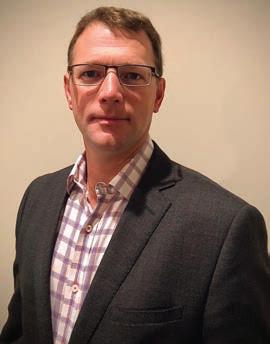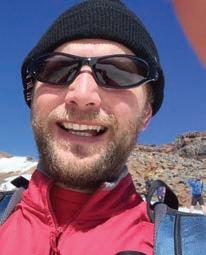
12 minute read
In Focus – Mark Crawford
IN FOCUS - Meet Mark Crawford - the new CIBSE ANZ Chair
Mark Crawford, newly appointed CIBSE ANZ Chair and Director of MCL, discusses projects he is currently working on, his tips and tricks for working effectively from home, plus how he is steering the CIBSE ANZ Chair in 2020 and beyond.

Tell us a little bit about what you do, where you come from, noteworthy projects you worked on and career highlights, personal hobbies/ interests.
I was born in Kent in southeast England and grew up in a little village (Cliffe) in the north of the county. Whizzing forward a few years I graduated in electrical and electronic engineering (B.Eng (Hons)) from Loughborough University in 1992. As there was a bit of a recession on at that time I could not get a graduate job. So I took a job as a commissioning engineer with a company that my friend’s father ran. I soon realised that I was well suited to commissioning as I enjoyed making things work and solving problems. Two years later I went free-lance and operated a successful commissioning management business for the next ten years.
This took me to 2004. I was working on the Mellon Bank project in Blackfriars when I had a beer or two with the lead engineering consultant, who happened to be a Kiwi. We soon decided that we should go into business together (may have been influenced by the beer?). We soon set up GAP Engineering and rented a small office near the Monument in central London. My Kiwi partner, Greg, used to work for a wellrespected and growing NZ consultancy called Beca, Carter, Hollings and Ferner Limited. They found out about our little set up and approached us with an interesting offer to become the Beca London office. After some serious consideration, we agreed.
This went well and some two and a bit years later I was offered the opportunity to spend a year in the Auckland office with my family. Timing was right for us (we had to consider schooling arrangements for my two children), so we rented out our house and took off for the antipodes. We all loved living in NZ, so when our letting agent in the UK advised that someone had expressed an interest in buying our house we decided to stay. We have now been in NZ for over 13 years.
For most of that time I continued to work for Beca but in mid-2019 I went back to being a free-lance engineer. I now operate a limited company, MCL, providing commissioning management and mission critical
engineering services to the industry. Projects I have been involved with over the years include:
UK W aterloo International Terminal The British Library Guy’s Hospital Various commercial offices, such as Paddington Central, Credit Suisse, Barclays Bank and Mellon Bank Various pharmaceutical establishments, such as Glaxo Smithkline, Merke, Sharpe & Dohme and Millennium Pharmaceutical in Cambridge
Various data centres, including, UBS Bank, Barclays Bank, Level 3 Communications, JB Morgan Chase and various UK Government buildings NZ and overseas V arious commercial offices, including the first Greenstar 5-star buildings in NZ (Meridian Building in Wellington, Telecom House in Auckland) NZ Defence Force projects, including helicopter hangers, simulators and maintenance support facilities. Data centres such as for Datacom, Telecom NZ and ANZ Bank, plus involvement with data centres in Singapore and Indonesia. Hospitals including the Auckland DHB sites, Taranaki Hospital and Christchurch Hospital
Why did you nominate yourself/ accept the ANZ Chair role. Why now?
Paul Angus approached me in early 2019 and asked if I would be interested in stepping into the role after him. This came as a complete surprise to me. I immediately suggested that there must be a number of alternatives that would be better suited. Paul advised that I had a lot of support within the committee and should very much consider taking on the role.
At this time I was also going through the process of setting up MCL, my new business venture. I was initially concerned about balancing the needs of my business with the needs of the role of chair for CIBSE. After a good deal of deliberation I realised that I would be able to manage both of these needs. In fact it should be easier as a business owner as I will be able to control how I spend my time.

So, humbly and with much gratitude, I decided to accept the role of chair for the CIBSE ANZ region. I am very fortunate to have a fantastic committee to work with to assist me, including a great Vice Chair (Phil Senn), who is Sydney based. Phil’s assistance will be paramount in the operation of CIBSE ANZ and will provide the necessary touch point in Australia with me being in NZ. I have also had Paul’s promise of support, which I will most definitely need at times.
This is the first time the region has had a NZ chair (I think), what do you see as the benefit of change? (feel free to remind readers that we have vicechair in Australia to balance representation and drive the agenda in both countries)
I was surprised to find out that there has not been an NZ chair of CIBSE ANZ before. It is a real privilege to be the first to provide this. The Australia and New Zealand Region is vast in size and we have our own ways to do things. This is true when compared with the rest of the world and, to a lesser extent, on either side of the Tasman. Our work in Australia and New Zealand is globally recognised. This can be seen by the recipients of International Project of the Year Awards over the last few years.
I do not like to think of NZ being a poorer cousin to Australia, but it is clear the budgets are larger on the Western Isle of the Antipodes. This requires innovation by Kiwi engineers to be innovative in their thinking to produce world leading buildings. Sharing ideas with our transTasman cousins helps our region develop quicker and stronger than working alone.
As a NZ based Chair, I hope to encourage more Kiwi engineers to step and get involved with CIBSE and industry bodies. Engineers tend to be modest but passionate folk. We all need to channel our energies into our industry. As individuals we can make a difference. As an organisation we can change lives.
I am fortunate to have an awesome ViceChair, Phil Senn, who is Sydney based. He will be the touch point for Australian members on a day-to-day basis. Between us we shall endeavour to serve the whole ANZ region. As I mentioned earlier, it is a vast region, so if you have any ideas on how to improve your interaction with CIBSE we will be very pleased to hear them.
What current project are you excited to be working on?
I am engaged as the commissioning manager for the Facilities Infrastructure Upgrade Project (FIRP) for Auckland District Health Board (ADHB). It is really exciting to be part of such a major programme of works so early in the timeline. I have also been requested to implement Soft Landings on a number of the projects. I am really interested to document the process then observe the outcomes. I am writing a regular article for the ENGineering Buildings journal so that other interested engineers can follow the progress.
What area of building services engineering are you passionate about? (i know commissioning is up there but I have to ask)
I really do not like it when equipment is not running correctly. It drives me mad to see all the effort of design and installation go to waste because the system has not been correctly commissioned. So this has led to me having a passion for commissioning and commissioning management. It suits my character.
I also do not like waste. Good commissioning also optimises energy usage. From my perspective the benefits of good commissioning are many with no downside that I can see. There is always the argument around cost for commissioning management, but the return on investment is easy to demonstrate. Some of the unrecognised benefits of a well-managed commissioning process is the reduction in stress during the tail-end of a project. Each service is commissioned in the right sequence to deliver the right outcome. As the work has been planned in advance these activities are often only performed once, correctly. This leads to happy contractors, a good hand-over process, good documentation and a delighted client. It’s win, win, win!
How has working from home changed the way you work personally and as a team?
I have really embraced the use of video conferencing software, such as Zoom or Teams. Whilst it is not the same as a faceto-face it is a fairly close alternative. I am an advocate for working from home when it is appropriate. I am a strong believer in getting a good work / life balance and the ability to work from home certainly helps. I get a bit more time in bed as there is no commute. I get to eat lunch and dinner with my family. This is very important time for any family and something I miss out on normally. I also get a walk along the beach every day with my wife. I will be aiming to spend more days working from home.
Do you have any tips on getting the most out of working from home?
Since setting up my own business last year I have set up an office at home in our upstairs rumpus room. When I am working I can go upstairs and shut myself away. I find I can work effectively there. I go down for lunch with my family, which is a good routine to maintain. I also had ultrafast fibre broadband installed so my connectivity is fantastic. If you are relying on technology to operate then it should be of a good quality.
What excites you about being a building services engineer?
Even after more than 28 years in the industry I still learn something new every day. The spectrum of services that fall under the umbrella of building services is vast, with numerous exciting opportunities. Building Services’ Engineers make a difference to virtually everyone’s life in some way or other, often without acknowledgement. This kind of sums up engineers: we make a positive difference to your lives, but we don’t like to shout about it.
If you were given an opportunity to change careers, would you and what would you do?
I really love motorcycling. I often wonder if I could have made a career as a professional racer. It is a lifestyle that suits my alter ego.
Your response to the 2020 Young Engineers Awards question: “What changes need to occur in planning the built environment today to help achieve a desirable, highperforming, sustainable built environment one decade on?”
Hmm, a tricky question.
Firstly, the industry leaders need to agree on what they are trying to achieve. Low energy buildings are easy to build, but they may not be comfortable or nice places to occupy. A clear message needs to be sent out by the industry, hopefully endorsed by our respective governments.
Building owners then need to make it clear they will not accept incomplete or poorly performing buildings. Commissioning must be performed correctly. Handovers must be a great experience. Post occupancy involvement of key members of the design and construction team will add value. Continual optimisation of plant is necessary.
We all have a part to play. We need to do our jobs well, provide great advice and not cut corners. Saving a few cents in the design phase may end up costing many dollars during the operational phase, not to mention the waste in energy.
Collaboration is key. We need to work together as a well-drilled team, all aiming for a common goal.
What would you like your legacy as CIBSE ANZ Chair to be?
To raise the profile of good commissioning and commissioning management across the region.
JOIN CIBSE AS A STUDENT MEMBER
Be supported through your studies and future career, with all the building services knowledge you need in one place.
CIBSE Student members benefit from:
• Free monthly subscription to the CIBSE Journal* and Student Newsletter
• Free and unlimited access to the CIBSE Knowledge Portal, a comprehensive online library that contains the full range of CIBSE published guidance
• Substantial discounts on CIBSE events, training courses, online learning modules and hardcopy publications
• Countless networking and professional development opportunities to advance your career
*Full-time students will receive an e-copy of the CIBSE Journal. Membership is free for full-time students and at a significantly discounted fee for those studying part-time.
Sustainability requires a high level of integration between HVAC, lighting, and security systems. The art of building sustainability skillfully combines this integration with other technological and supporting elements that must endure over the long term. When these additional elements are maintained over the life of your building, true building sustainability emerges. To learn more about the ART of Building Sustainability please visit reliablecontrols.au.com/TABS11E19.
Ensure a strong level of interoperability by using open protocols which have third-party listing laboratories to verify adherence to your protocol’s form and function.
Employ a single sign on (SSO) architecture with compliance to scalable credentialing architectures and secure tunneling methodologies such as BACnet virtual private networks (B/VPN).
Specify integrated FDD (IFDD) that delivers real-time fault detection, step-by-step root-cause diagnostics while using all your existing cabling structures, including twisted-pair networks. 1

Insist on timely analytics for all stakeholders with complete control of formatting and scheduling while retaining full ownership of your data and the reports generated.
the ART of Building Sustainability
Choose from a global network of factory-certified service partners who are passionate about long term, consistent, local support for you and your buildings. Stay on top of regular advances in technology with supplier-certified, multi-lingual online educational videos, technical documentation, software updates, and advanced face-to-face classroom courses.
Enjoy the long-term benefits of suppliers who engineer a path forward to new technologies while remaining backwards compatible without third-party gateways or hardware replacement.

Select lifecycle-centric manufacturers who minimize the negative impacts of waste with long-term warranty and repair services while adhering to WEEE, RoHS and NABERS directives.
Create better-connected spaces with real-time access to occupancy, lighting, ventilation, and thermal comfort levels, using a holistic single app on the occupant’s mobile device.










